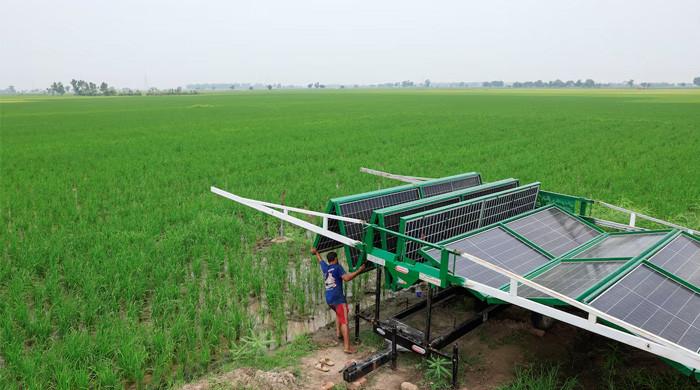
- Farmers ditching diesel, grid power for sun-powered tube wells.
- Water tables rapidly depleting in South Asia’s bread basket Punjab.
- Agriculture sector’s electricity usage to drop by 45% in three years.
Karamat Ali’s cows and buffalos once provided his multi-generational family with milk. But earlier this year, the 61-year-old sold about a dozen bovine — and spent the proceeds on a set of solar panels.
The rice farmer in Punjab now uses his panels to power a tube well, which is composed of a water well and a motorised groundwater pump. The device allows Ali to irrigate his crops with greater ease and frees him from depending on the erratic electricity grid and pricey diesel to power the pump.
“Water supply to my paddy feed is smoother than before,” he said.
As the country undergoes a solar revolution, farmers like Ali are increasingly ditching diesel and grid power for sun-powered tube wells, according to interviews with 10 growers, as well as government officials and analysts.
The solar boom has coincided with the rapid depletion of water tables in the most populous province, according to previously unreported Punjab water authority documents viewed by Reuters. The documents did not pinpoint any cause.
Six of the farmers told Reuters that they had started irrigating their rice paddies far more regularly — including up to several times a day as part of a practice known as pulse irrigation — which would not have been possible without solar water pumps.
Farmers are also choosing to grow more thirsty rice crops than in previous years, with the size of rice fields in the country increasing 30% between 2023 and 2025, US Department of Agriculture data show. Meanwhile, the amount of land dedicated to growing less water-intensive maize fell 10%.

There are no recent official estimates on the number of tube wells in Pakistan, which doesn’t require their registration. But so widespread is their use that farmers choosing to power the devices with solar are set to drive a 45% collapse in the amount of grid electricity consumed by the agriculture sector in the three years through 2025, said energy economist Ammar Habib, who serves as an adviser to power minister. His estimate was based on consumption data published by the national energy authority.
Reuters’ calculations based on Habib’s data, which were reviewed by Habib and Lahore-based renewables analyst Syed Faizan Ali Shah, indicate that some 400,000 tube wells that once relied on grid electricity have switched to solar.
Farmers using solar panels have likely purchased an additional 250,000 tube wells since 2023, Habib estimates, signalling that the sun now powers roughly 650,000 such devices across the countru.
Details about the scale of Pakistani agriculture’s transition to solar and its impact on groundwater are being reported for the first time.

The solar boom in the country, which was encouraged by a sharp increase in power tariffs in 2023, is being replicated worldwide. Heavy production of solar panels in China has driven an 80% collapse in prices of the modules since 2017, prompting farmers from lushly forested Brazil to drought-prone Iraq to turn to the sun to power their irrigation systems.
The explosion in availability of cheap solar panels is posing a particular threat to water levels in the South Asian bread basket of Punjab.
The water table has shrunk below 60 feet — a level designated as critical by the provincial irrigation department — across 6.6% of Punjab as of 2024, according to maps published for internal use by water authorities and seen by Reuters.
That marks an increase of some 25% between 2020 and 2024, while the deepest pockets — with water levels beyond 80 feet — more than doubled in size during the same period.
Federal Minister for Energy Awais Leghari told Reuters in June that it was a “misconception that solar tube wells are depleting groundwater”.
Farmers using devices were drawing similar amounts of water as before, he said. “The land under cultivation hasn’t increased. They’re just replacing expensive diesel with solar”.
The minister didn’t respond when presented in September with the accounts of farmers indicating that they had increased their irrigation of crops and data showing an expansion in rice fields.
Solarisation is “good for the environment because it’s clean energy,” said Punjab irrigation minister Muhammad Kazim Pirzada. “But at the same time, it is also impacting our water table”.
His department told Reuters it was continuing to study the relationship between tube wells and groundwater depletion, but that it had undertaken measures to protect the water table. Recent flooding also affected some of the dryer areas in Punjab, possibly recharging some water tables, the minister added.
Panels and paddy
Pakistan, one of the world’s most water-stressed nations, has found itself embroiled in conflicts over the resource with its upstream neighbour India, with whom it briefly fought in May.
But for many farmers in Punjab, the threat to the water table is a problem for tomorrow.
Growers have been battered by a years-long fall in the global price of wheat, Punjab’s staple crop. Rural poverty in the country spiked to a record high in May 2023 and remains elevated after an International Monetary Fund (IMF) bailout that year that imposed higher energy tariffs and taxes.
The switch to solar has allowed 61-year-old Mohammad Naseem to save some Rs2 million(about $7,000) — or more than quadruple country’s gross domestic product per capita — in power costs since he bought his panels four years ago.

The ability to irrigate at will has increased production modestly by between 400 and 600 kg of rice each year, he said, though the quality of the crop yield has improved, allowing Naseem to obtain better prices.
“I wash it with water. I sleep near it,” said Naseem, who prizes his panels so much that he dismantles them every evening and brings them home from the fields to prevent possible theft.
“Solar panels should be installed at all costs,” said 38-year-old subsistence farmer Rai Abdul Ghafoor, who has been saving for a purchase.
While poorer farmers like Ghafoor are still reliant on diesel and grid power, many agriculture-dependent villages have pooled sums to purchase the panels as communal property.
Haji Allah Rakha, an 80-year-old farmer who has 16 panels, shares them with two other families. “They contribute, and we all benefit,” he said.
“Farmers share, rent and move panels like tractors,” said Lahore-based solar-panel merchant Shahab Qureshi. “They sell land, jewellery, or take loans just to get it. Within five to six months, your return on investment is fulfilled”.
Raise groundwater
Federal and provincial officials have started to pay more attention to the slow-boiling crisis, especially after India suspended its participation in an accord governing the sharing of water from the critical Indus river system earlier this year.
Punjab began aquifer-recharge pilots, which aim to slow depletion and ensure stable groundwater supply, at more than 40 sites before India’s April move, though officials said such projects have grown in importance since.
“This is our small effort to return the due share to the aquifer,” said Adnan Hassan, a researcher for Punjab’s irrigation department. “If polluted water is injected (due to over-extraction), the next generation will suffer.”

The province is also reviving old infrastructure such as the Ravi Siphon, a colonial-era tunnel that helps stabilise flows from the Ravi River. Officials hope that improving conventional irrigation methods will reduce the need for farmers to extract groundwater.
Independent environmental scientist Imran Saqib Khalid said the country still lacks measures like the comprehensive mapping of wells and real-time monitoring of withdrawals that would contain the water crisis.
The solar push lacks “any method to the madness,” he said, adding that without a change in governance, groundwater depletion would continue unabated: “In the long run, this will have an impact on cropping intensities and the types of crops we can grow, which in turn will impact our food security”.
Discover more from Brackly News
Subscribe to get the latest posts sent to your email.



